1804_AFM.pdf
Robotics and Automation Handbook
Preface
The Editor
Contributors
Contents
1804_C01.pdf
Robotics and Automation Handbook
Contents
Chapter 1
The History of Robotics
1.1 The History of Robotics
1.1.1 The Influence of Mythology
1.1.2 The Influence of Motion Pictures
1.1.3 Inventions Leading to Robotics
1.1.4 First Use of the Word
1.1.5 First Use of the Word
1.1.6 The Birth of the Industrial Robot
1.1.7 Robotics in Research Laboratories
1.1.8 Robotics in Industry
1.1.9 Space Exploration
1.1.10 Military and Law Enforcement Applications
1.1.11 Medical Applications
1.1.12 Other Applications and Frontiers of Robotics
1804_C02.pdf
Robotics and Automation Handbook
Contents
Chapter 2
Rigid-Body Kinematics
2.1 Rotations in Three Dimensions
2.1.1 Rules for Composing Rotations
2.1.2 Euler Angles
2.1.3 The Matrix Exponential
2.2 Full Rigid-Body Motion
2.2.1 Composition of Motions
2.2.2 Screw Motions
2.3 Homogeneous Transforms and the Denavit-Hartenberg Parameters
2.3.1 Homogeneous Transformation Matrices
2.3.2 The Denavit-Hartenberg Parameters in Robotics
2.4 Infinitesimal Motions and Associated Jacobian Matrices
2.4.1 AngularVelocity and Jacobians Associated with Parametrized Rotations
2.4.2 The Jacobians for ZXZ Euler Angles
2.4.3 Infinitesimal Rigid-Body Motions
Further Reading
References
1804_C03.pdf
Robotics and Automation Handbook
Contents
Chapter 3
Inverse Kinematics
3.1 Introduction
3.2 Preliminaries
3.2.1 Existence and Uniqueness of Solutions
3.2.2 Notation and Nomenclature
3.3 Analytical Approaches
3.3.1 Reduction of Inverse Kinematics to Subproblems
3.3.1.1 Inverse Kinematics for Two Examples via Subproblems
3.3.2 Pieper’s Solution
3.3.2.1 Simplifying Case Number 1: a1 = 0
3.3.2.2 Simplifying Case Number 2: α1 = 0
3.3.2.3 General Case when a1 = 0 and α1 = 0
3.3.3 Example
3.3.4 Other Approaches
3.3.4.1 Dialytical Elimination
3.3.4.2 Zero Reference Position Method
3.4 Numerical Techniques
3.4.1 Newton’s Method
3.4.2 Inverse Kinematics Solution Using Newton’s Method
3.5 Conclusions
Appendix A: Theorems Relating to Newton’s Method
Appendix B: Implementation of Newton’s Method
B.1 File ‘‘inversekinematics.c’’
B.2 File ‘‘computejacobian.c’’
B.3 File ‘‘forwardkinematics.c’’
B.4 File ‘‘homogeneoustransformation.c’’
B.5 File ‘‘matrixinverse.c’’
B.6 File ‘‘matrixproduct.c’’
B.7 File ‘‘inversekinematics.h’’
B.8 File ‘‘dh.dat’’
B.9 File ‘‘Tdes.dat’’
B.10 File ‘‘theta.dat’’
References
1804_C04.pdf
Robotics and Automation Handbook
Contents
Chapter 4
Newton-Euler Dynamics of Robots
4.1 Introduction
4.1.1 Scope
4.1.2 Background
4.2 Theoretical Foundations
4.2.1 Newton-Euler Equations
4.2.2 Force and Torque Balance on an Isolated Link
4.2.3 Two-Link Robot Example
4.2.4 Closed-Form Equations
4.3 Additional Considerations
4.3.1 Computational Issues
4.3.2 Moment of Inertia
4.3.3 Spatial Dynamics
4.4 Closing
References
1804_C05.pdf
Robotics and Automation Handbook
Contents
Chapter 5
Lagrangian Dynamics
5.1 Introduction
5.2 Preliminaries
5.2.1 Velocities and Forces
5.2.2 Kinematics of Serial Linkages
5.3 Dynamic Equations
5.3.1 Inertial Properties of a Rigid Body
5.3.2 Euler-Lagrange Equations for Rigid Linkages
5.3.3 Generalized Force Computation
5.3.4 Geometric Interpretation
5.4 Constrained Systems
5.4.1 Geometric Interpretation
5.5 Impact Equations
5.6 Bibliographic Remarks
5.7 Conclusion
References
1804_C06.pdf
Robotics and Automation Handbook
Contents
Chapter 6
Kane’s Method in Robotics
6.1 Introduction
6.2 The Essence of Kane’s Method
6.3 Two DOF Planar Robot with Two Revolute Joints
6.3.1 Preliminaries
6.3.2 Generalized Coordinates and Speeds
6.3.3 Velocities
6.3.4 Partial Velocities
6.3.5 Accelerations
6.3.6 Generalized Inertia Forces
6.3.7 Generalized Active Forces
6.3.8 Equations of Motion
6.3.9 Additional Considerations
6.4 Two-DOF Planar Robot with One Revolute Joint and One Prismatic Joint
6.4.1 Preliminaries
6.4.2 Generalized Coordinates and Speeds
6.4.3 Velocities
6.4.4 Partial Velocities
6.4.5 Accelerations
6.4.6 Generalized Inertia Forces
6.4.7 Generalized Active Forces
6.4.8 Equations of Motion
6.5 Special Issues in Kane’s Method
6.5.1 Linearized Equations
6.5.2 Systems Subject to Constraints
6.5.3 Continuous Systems
6.5.3.1 Preliminaries
6.5.3.2 Kinematics
6.6 Kane’s Equations in the Robotics Literature
6.7 Commercially Available Software Packages Related to Kane’s Method
6.7.1 SD/FAST
6.7.2 Pro/ENGINEER Simulation (formerly Pro/MECHANICA)
6.7.3 AUTOLEV
6.7.4 ADAMS
6.7.5 Working Model
6.8 Summary
References
1804_C07.pdf
Robotics and Automation Handbook
Contents
Chapter 7
The Dynamics of Systems of Interacting Rigid Bodies
7.1 Introduction
7.2 Newton’s Law and the Covariant Derivative
7.3 Newton’s Law in a Constrained Space
7.4 Euler’s Equations and the Covariant Derivative
7.5 Example 1: Euler’s Equations for a Rigid Body
7.6 The Equations of Motion of a Rigid Body
7.7 Constraint Forces and Torques between Interacting Bodies
7.8 Example 2: Double Pendulum in the Plane
7.9 Including Forces from Friction and from Nonholonomic Constraints
7.10 Example 3: The Dynamics of the Interaction of a Disk and a Link
7.11 Example 4: Including Friction in the Dynamics
7.12 Conclusions
References
1804_C08.pdf
Robotics and Automation Handbook
Contents
Chapter 8
D-H Convention
8.1 Introduction
8.2 D-H Parameters
8.3 Algorithm for Determining the Homogenous Transformation Matrix, A.n
8.4 Examples
Example 8.1
Example 8.2: The SCARA Robot
Example 8.3: The Stanford Arm
Example 8.4: The Mitsubishi PA-10 Robot Arm
Example 8.5: The PUMA 600 Robot Arm
1804_C09.pdf
Robotics and Automation Handbook
Contents
Chapter 9
Trajectory Planning for Flexible Robots
9.1 Introduction
9.2 Command Generation
9.2.1 Bridge Crane Example
9.2.2 Generating Zero Vibration Commands
9.2.3 Using Zero-Vibration Impulse Sequences to Generate Zero- Vibration Commands
9.2.4 Robustness to Modeling Errors
9.2.5 Multi-Mode Input Shaping
9.2.6 Real-Time Implementation
9.2.7 Applications
9.2.8 Extensions Beyond Vibration Reduction
9.3 Feedforward Control Action
9.3.1 Feedforward Control of a Simple System with Time Delay
9.3.2 Feedforward Control of a System with Nonlinear Friction
9.3.3 Zero Phase Error Tracking Control
9.3.4 Conversion of Feedforward Control to Command Shaping
9.4 Summary
References
1804_C10.pdf
Robotics and Automation Handbook
Contents
Chapter 10
Error Budgeting
10.1 Introduction
10.2 Probability in Error Budgets
10.3 Tolerances
10.4 Error Sources
10.5 Kinematic Modeling
10.6 Assessing Accuracy and Process Capability
10.6.1 Sensitive Directions
10.6.2 Correlation among Multiple Criteria
10.6.3 Interactions among Processing Steps
10.6.4 Spatial Distribution of Errors
10.7 Modeling Material Removal Processes
10.8 Summary
References
1804_C11.pdf
Robotics and Automation Handbook
Contents
Chapter 11
Design of Robotic End Effectors
11.1 Introduction
11.2 Process and Environment
11.2.1 System Design
11.2.2 Special Environments
11.3 Robot Attachment and Payload Capacity
11.3.1 Integrated End Effector Attachment
11.3.2 Attachment Precision
11.3.3 Special End Effector Locations
11.3.4 Wrist Compliance: Remote Compliance Centers
11.3.5 Payloads
11.3.6 Payload Force Analysis
11.4 Power Sources
11.4.1 Compressed Air
11.4.2 Vacuum
11.4.3 Hydraulic Fluid Power
11.4.4 Electrical Power
11.4.5 Other Actuators
11.5 Gripper Kinematics
11.5.1 Parallel Axis/Linear Motion Jaws
11.5.2 Pivoting/Rotary Action Jaws
11.5.3 Four-Bar Linkage Jaws
11.5.4 Multiple Jaw/Chuck Style
11.5.5 Articulating Fingers
11.5.6 Multi-Component End Effectors
11.6 Grasping Modes, Forces, and Stability
11.6.1 Grasping Stability
11.6.2 Friction and Grasping Forces
11.7 Design Guidelines for Grippers and Jaws
11.7.1 Gripper and Jaw Design Geometry
11.7.2 Gripper Design Procedure
11.7.3 Gripper Design: Case Study
11.7.4 Gripper Jaw Design Algorithms
11.7.5 Interchangeable End Effectors
11.7.6 Special Purpose End Effectors/Complementary Tools
11.8 Sensors and Control Considerations
11.8.1 Proximity Sensors
11.8.2 Collision Sensors
11.8.3 Tactile Feedback/Force Sensing
11.8.4 Acceleration Control for Payload Limits
11.8.5 Tactile Force Control
11.9 Conclusion
References
1804_C12.pdf
Robotics and Automation Handbook
Contents
Chapter 12
Sensors and Actuators
12.1 Encoders
12.1.1 Rotary and Linear Incremental Encoders
12.1.2 Tachometer
12.1.3 Quadrature Encoders
12.1.4 Absolute Encoders
12.2 Analog Sensors
12.2.1 Analog Displacement Sensors
12.2.1.1 Potentiometers
12.2.1.2 Linear Variable Differential Transformers (LVDT)
12.2.1.3 Resolvers
12.2.1.4 Inductive (Eddy Current)
12.2.1.5 Capacitive
12.2.1.6 Optical Sensors
12.2.1.6.1 Optical Triangulation
12.2.1.6.2 Optical Time-Of-Flight
12.2.1.6.3 Analog Photoelectric
12.2.1.7 Ultrasonic Sensors
12.2.1.8 Hall Effect Sensors
12.2.2 Strain
12.2.3 Force and Torque
12.2.4 Acceleration
12.3 Digital Sensors
12.3.1 Switches as Digital Sensors
12.3.2 Noncontact Digital Sensors
12.3.3 Solid State Output
12.3.4 Common Uses for Digital Sensors
12.3.4.1 Proximity Sensors
12.3.4.2 Limit Switches and Sensors
12.3.4.3 Light Curtains
12.4 Vision
12.5 Actuators
12.5.1 Electromagnetic Actuators
12.5.1.1 Solenoid
12.5.1.2 Stepper Motors
12.5.1.3 DC Brush Motor
12.5.1.4 DC Brushless Motor
12.5.2 Fluid Power Actuators
12.5.2.1 Hydraulic Actuators
12.5.2.2 Pneumatic Actuators
References
1804_C13.pdf
Robotics and Automation Handbook
Contents
Chapter 13
Precision Positioning of Rotary and Linear Systems
13.1 Introduction
13.2 Precision Machine Design Fundamentals
13.2.1 Definitions of Precision
13.2.2 Determinism
13.2.3 Alignment Errors (Abbe Principle)
13.2.4 Force and Metrology Loops
13.2.5 Constraint
13.2.5.1 Exact-Constraint or Kinematic Design
13.2.5.2 Elastic Averaging
13.2.6 Thermal Management
13.2.7 Cable Management
13.2.8 Environmental Considerations
13.2.9 Serviceability and Maintenance
13.3 Mechatronic Systems
13.3.1 Definition of Mechatronic Systems
13.3.2 Discrete-Time System Fundamentals
13.3.2.1 Sampling and Aliasing
13.3.2.2 Quantization
13.3.2.2.1 Analog-to-Digital Conversion
13.3.2.2.2 Encoders and Incremental Position Sensors
13.3.2.2.3 Digital-to-Analog Conversion
13.3.3 Precision Mechanics
13.3.3.1 Linear and Rotary Bearings
13.3.3.2 Machine Structure
13.3.3.3 Vibration Isolation
13.3.4 Controller Implementation
13.3.4.1 Feedback Control Hardware
13.3.4.2 Power Amplifiers
13.3.4.3 Actuators
13.3.5 Feedback Sensors
13.3.5.1 Rotary Encoders
13.3.5.2 Linear Encoders
13.3.5.3 Laser Interferometers
13.3.5.4 Analog Sensors
13.3.6 Control Algorithms
13.3.6.1 System Modeling
13.3.6.2 Feedback Compensation
13.3.6.3 Feedforward Compensation
13.4 Conclusions
References
1804_C14.pdf
Robotics and Automation Handbook
Contents
Chapter 14
Modeling and Identification for Robot Motion Control
14.1 Introduction
14.2 Robot Modeling for Motion Control
14.2.1 Kinematic Modeling
14.2.2 Modeling of Rigid-Body Dynamics
14.2.3 Friction Modeling
14.3 Estimation of Model Parameters
14.3.1 Estimation of Friction Parameters
14.3.2 Estimation of BPS Elements
14.3.2.1 Batch LS Estimation of BPS
14.3.2.2 Online Gradient Estimator of BPS
14.3.3 Design of Exciting Trajectory
14.3.4 Online Reconstruction of Joint Motions, Speeds, and Accelerations
14.4 Model Validation
14.5 Identification of Dynamics Not Covered with a Rigid-Body Dynamic Model
14.6 Case-Study: Modeling and Identification of a Direct-Drive Robotic Manipulator
14.6.1 Experimental Set-Up
14.6.2 Kinematic and Dynamic Models in Closed Form
14.6.3 Establishing Correctness of the Models
14.6.4 Friction Modeling and Estimation
14.6.5 Estimation of the BPS
14.6.6 Dynamics Not Covered with the Rigid-Body Dynamic Model
14.7 Conclusions
References
1804_C15.pdf
Robotics and Automation Handbook
Contents
Chapter 15
Motion Control by Linear Feedback Methods
15.1 Introduction
15.2 Decentralized Conventional Feedback Control
15.3 Linear Feedback Control Applied with Nonlinear Model- Based Dynamic Compensators
15.3.1 Computed-Torque Control Design
15.3.2 Control Designs with Feedback Linearization
15.4 Case-Study: Motion Control of the RRR Direct-Drive Manipulator
15.4.1 Nominal Plant Model
15.4.2 Conventional Feedback Control Design
15.4.3 µ-Synthesis Feedback Control Design
15.4.4 Experimental Evaluation
15.5 Conclusions
References
1804_C16.pdf
Robotics and Automation Handbook
Contents
Chapter 16
Force/Impedance Control for Robotic Manipulators
16.1 Introduction
16.2 Dynamic Model
16.2.1 Joint-Space Model
16.2.2 Task-Space Model and Environmental Forces
16.3 Stiffness Control
16.3.1 Controller Design
16.4 Hybrid Position/Force Control
16.4.1 Controller Design
16.4.1.1 Tangential Position Control Component
16.4.1.2 Normal Force Control Component
16.5 Hybrid Impedance Control
16.5.1 Types of Impedance
16.5.2 Duality Principle
16.5.2.1 Velocity Step-Input
16.5.2.2 Force Step-Input
16.5.3 Controller Design
16.6 Reduced Order Position/Force Control
16.6.1 Holonomic Constraints
16.6.2 Reduced Order Model
16.6.3 Reduced Order Controller Design
16.7 Background and Further Reading
References
1804_C17.pdf
Robotics and Automation Handbook
Contents
Chapter 17
Robust and Adaptive Motion Control of Manipulators*
17.1 Introduction
17.2 Background
17.2.1 Kinematics
17.2.2 Dynamics
17.2.3 Properties of Rigid Robot Dynamics
17.3 Taxonomy of Control Design Methods
17.3.1 Control Architecture
17.3.2 Feedback Linearization Control
17.3.3 Joint Space Inverse Dynamics
17.3.4 Task Space Inverse Dynamics
17.3.5 Robust Feedback Linearization
17.3.5.1 Stable Factorizations
17.3.5.2 Lyapunov’s Second Method
17.3.5.3 Sliding Modes
17.3.6 Adaptive Feedback Linearization
17.3.7 Passivity-Based Approaches
17.3.8 Passivity-Based Robust Control
17.3.9 Passivity-Based Adaptive Control
17.3.10 Hybrid Control
17.4 Conclusions
References
1804_C18.pdf
Robotics and Automation Handbook
Contents
Chapter 18
Sliding Mode Control of Robotic Manipulators
18.1 Sliding Mode Controller Design -- An Overview
18.2 The Sliding Mode Formulation of the Robot Manipulator Motion Control Problem
18.3 Equivalent Control and Chatter Free Sliding Control
18.4 Control of Robotic Manipulators by Continuous Sliding Mode Laws
18.4.1 Sliding Mode Formulation of the Robotic Manipulator Motion Control Problem
18.4.2 Sliding Mode Controller Design
18.5 Conclusions
References
1804_C19.pdf
Robotics and Automation Handbook
Contents
Chapter 19
Impedance and Interaction Control
19.1 Introduction: Controlling Mechanical Interaction
19.1.1 The Effect of Interaction on Performance and Stability
19.1.2 Interaction as Disturbance Rejection
19.1.3 Interaction as Modeling Uncertainty
19.2 Regulating Dynamic Behavior
19.2.1 Mechanical Impedance and Admittance
19.2.2 Port Behavior and Transfer Functions
19.3 Analyzing Coupled Systems
19.3.1 Causal Analysis of Interaction Port Connection
19.3.2 Impedance vs. Admittance Regulation
19.3.3 Coupled System Stability Analysis
19.3.4 Passivity and Coupled Stability
19.4 Implementing Interaction Control
19.4.1 Virtual Trajectory and Nodic Impedance
19.4.2 ‘‘Simple’’ Impedance Control
19.4.3 Direct Impedance Modulation
19.5 Improving Low-Impedance Performance
19.5.1 Force Feedback
19.5.2 Natural Admittance Control
19.5.3 Series Dynamics
19.6 More Advanced Methods
19.7 Conclusion: Interaction Control, Force Control, and Motion Control
References
1804_C20.pdf
Robotics and Automation Handbook
Contents
Chapter 20
Coordinated Motion Control of Multiple Manipulators
20.1 Introduction
20.2 Manipulation of an Object
20.3 Coordinated Motion Control of Multiple Manipulators for Handling an Object
20.3.1 Motion of Object and Control of Internal Force/Moment
20.3.2 Load Sharing Problem
20.4 Coordinated Motion Control Based on Impedance Control Law
20.4.1 Design of Impedance for Handling an Object
20.4.2 Design of Impedance for RCC Dynamics
20.5 Decentralized Motion Control of Multiple Mobile Manipulators
20.5.1 Multiple Mobile Manipulators
20.5.2 Leader-Follower Type Control Algorithm
References
1804_C21.pdf
Robotics and Automation Handbook
Contents
Chapter 21
Robot Simulation
21.1 Introduction
21.2 Example Applications
21.2.1 Factory Floor Simulation
21.2.2 Nuclear Waste Remediation Simulation
21.2.3 Surgical Simulation
21.3 Robot Simulation Options
21.3.1 Where Do You Start
21.3.2 Robot Design Packages
21.3.3 Animation of Robot Motion
21.3.3.1 High End Robot Simulation Packages
21.3.3.2 Low Cost Robot Simulation Packages
21.3.4 Simulation of Robot Dynamics
21.3.4.1 Multibody Dynamic Packages
21.4 Build Your Own
21.4.1 Graphical Animation
21.4.2 Numerical Simulation
21.5 Conclusion
References
Appendix A: Matlab Code for The Single DOF Example
Appendix B: Matlab Code for The 3-DOF System, Full Sea State
1804_C22.pdf
Robotics and Automation Handbook
Contents
Chapter 22
A Survey of Geometric Vision
22.1 Introduction
22.1.1 Camera Model and Image Formation
22.1.1.1 The Hat Operator
22.1.1.2 Similarity
22.1.2 3-D Reconstruction Pipeline
22.1.3 Further Readings
22.1.3.1 Camera Calibration
22.1.3.2 Different Image Surfaces
22.1.3.3 Other Types of Projections
22.2 Two-View Geometry
22.2.1 Epipolar Constraint and Essential Matrix
22.2.2 Eight-Point Linear Algorithm
22.2.2.1 Coplanar Features and Homography
22.2.3 Further Readings
22.2.3.1 Small Baseline Motion and Continuous Motion
22.2.3.2 Multiple-Body Motions
22.2.3.3 Uncalibrated Camera
22.2.3.4 Critical Surface
22.2.3.5 Numerical Problems and Optimization
22.3 Multiple-View Geometry
22.3.1 Rank Condition on Multiple Views of Point Feature
22.3.2 Linear Reconstruction Algorithm
22.3.2.1 Coplanar Features
22.3.3 Further Readings
22.3.3.1 Multilinear Constraints and Factorization Algorithm
22.3.3.2 Universal Multiple-View Matrix and Rank Conditions
22.3.3.3 Dynamical Scenes
22.3.3.4 Orthographic Projection
22.4 Utilizing Prior Knowledge of the Scene --- Symmetry
22.4.1 Symmetric Multiple-View Rank Condition
22.4.2 Reconstruction from Symmetry
22.4.2.1 Planar Symmetry
22.4.3 Further Readings
22.4.3.1 Symmetry and Vision
22.4.3.2 Symmetry in Statistical Context
22.4.3.3 Symmetry of Surfaces and Curves
22.5 Comprehensive Examples and Experiments
22.5.1 Automatic Landing of Unmanned Aerial Vehicles
22.5.2 Automatic Symmetry Cell Detection, Matching and Reconstruction
22.5.2.1 Feature Extraction
22.5.2.2 Feature Matching
22.5.2.3 Reconstruction
22.5.3 Semiautomatic Building Mapping and Reconstruction
22.5.4 Summary
References
1804_C23.pdf
Robotics and Automation Handbook
Content
Chapter 23
Haptic Interface to Virtual Environments
23.1 Introduction
23.1.1 Related Technologies
23.1.2 Some Classifications
23.1.3 Applications
23.2 An Overview: System Performance Metrics and Specifications
23.2.1 Characterizing the Human User
23.2.2 Specification and Design of the Haptic Interface
23.2.3 Design of the Virtual Environment
23.3 Human Haptics
23.3.1 Some Observations
23.3.2 Some History in Haptics
23.3.3 Anticipatory Control
23.4 Haptic Interface
23.4.1 Compensation Based on System Models
23.4.2 Passivity Applied to Haptic Interface
23.5 Virtual Environment
23.5.1 Collision Detector
23.5.1.1 Broad Phase
23.5.1.2 Narrow Phase
23.5.2 Interaction Calculator
23.5.3 Forward Dynamics Solver
23.6 Concluding Remarks
References
1804_C24.pdf
Robotics and Automation Handbook
Contents
Chapter 24
Flexible Robot Arms
24.1 Introduction
24.1.1 Motivation Based on Higher Performance
24.1.2 Nature of Impacted Systems
24.1.3 Description of Contents
24.2 Modeling
24.2.1 Statics
24.2.1.1 Mechanics of Deformable Bodies
24.2.1.1.1 Stress vs. Strain
24.2.1.1.2 Material Properties
24.2.1.1.2.1 Elastic and Shear Modulus
24.2.1.1.2.2 Density
24.2.1.1.2.3 Strength
24.2.1.1.2.4 Damping
24.2.1.1.3 Idealized Structures and Loading
24.2.1.1.3.1 Bars and Compression
24.2.1.1.3.2 Shafts and Torsion
24.2.1.1.3.3 Beams and Bending
24.2.1.1.3.4 Combinations of Loading
24.2.1.1.4 Buckling
24.2.1.1.4.1 Column Buckling
24.2.1.1.4.2 Shell Buckling
24.2.1.1.4.3 Torsional Buckling
24.2.2 Kinematics
24.2.2.1 Transformation Matrices
24.2.2.2 Simple Kinematic Pairs
24.2.2.3 Closed Kinematic Chains
24.2.2.4 Kinematics of Deformation
24.2.3 Dynamics
24.2.3.1 Lumped Models
24.2.3.1.1 Lumped Inertia
24.2.3.1.2 Lumped Springs
24.2.3.1.3 Stiffness of a Series of Links
24.2.3.2 Dynamics of Lumped Masses and Massless Elastic Links with Servo Controlled Joints
24.2.4 Distributed Models
24.2.4.1 Distributed Bar Elements
24.2.4.2 Distributed Shaft Elements
24.2.4.3 Distributed Beam Elements in Bending
24.2.4.4 Combined Distributed Effects and Components
24.2.5 Frequency Domain Solutions
24.2.5.1 Eigenvalues and Corresponding Eigenfunctions
24.2.5.2 Frequency Response and Impulse Response
24.2.6 Discretization of the Spatial Domain
24.2.6.1 Finite Element Representations
24.2.6.2 Approximations of This Method
24.2.7 Simulation Form of the Equations
24.2.8 Inverse Dynamics Form of the Equations
24.2.9 System Characteristic Behavior
24.2.10 Reduction of Computational Complexity
24.3 Control
24.3.1 Independent Proportional Plus Derivative Joint Control
24.3.2 Advanced Feedback Control Schemes
24.3.2.1 Obstacles and Objectives for Advanced Schemes
24.3.2.2 State Feedback with Observers
24.3.2.3 Strain and Strain Rate Feedback
24.3.2.4 Passive Controller Design with Tip Position Feedback
24.3.2.5 Sliding Mode Control
24.3.3 Open Loop and Feedforward Control
24.3.3.1 Trajectory Specification
24.3.3.2 Filtering of Commands for Improved Trajectories
24.3.3.3 Learning Control
24.3.3.4 Inverse Dynamics for Trajectory Design
24.3.4 Design and Operational Strategies
24.3.4.1 Passive Damping Treatments
24.3.4.2 Augmentation of the Arm Degrees of Freedom
24.3.4.2.1 Bracing Strategies
24.3.4.2.2 Inertial Damping
24.3.4.2.3 Piezoelectric Actuation for Damping
24.4 Summary
References
1804_C25.pdf
Robotics and Automation Handbook
Contents
Chapter 25
Robotics in Medical Applications
25.1 Introduction
25.2 Advantages of Robots in Medical Applications
25.3 Design Issues for Robots in Medical Applications
25.4 Research and Development Process
25.5 Hazard Analysis
25.5.1 Hazard Identification
25.5.2 Verification and Validation
25.5.3 Initial and Final Risk Legend
25.5.4 Likelihood Determination
25.5.5 Severity Determination
25.5.6 Risk Acceptability
25.6 Medical Applications
25.6.1 Noninvasive Robotic Surgery --- CyberKnife Stereotactic Radiosurgery System
25.6.1.1 Introduction to Stereotactic Radiosurgery
25.6.1.2 Project Background
25.6.1.3 CyberKnife System
25.6.1.3.1 Radiation Source
25.6.1.3.2 Robot Manipulator
25.6.1.3.3 Stereo X-ray Imaging System
25.6.1.3.4 Patient Positioning System
25.6.1.3.5 Computer Software
25.6.1.4 Patient Safety
25.6.1.5 System Accuracy and Calibration
25.6.1.6 Robotic Advantages
25.6.2 Minimally Invasive Robotic Surgery --- da Vinci Surgery System
25.6.3 Invasive Robotic Surgery --- ROBODOC Surgical Assistant
25.6.4 Upcoming Products
Bibliography
1804_C26.pdf
Robotics and Automation Handbook
Contents
Chapter 26
Manufacturing Automation
26.1 Introduction
26.2 Process Questions for Control
26.3 Terminology
26.4 Hierarchy of Control and Automation
26.4.1 History
26.5 Controllers
26.5.1 PLC: Programmable Logic Controller
26.5.2 DCS: Distributed Control System
26.5.3 Hybrid Controller
26.5.4 Motion Controller
26.5.5 PC-Based Open Controller
26.6 Control Elements
26.6.1 HMI: Human-Machine Interface
26.6.2 I/O: Inputs and Outputs
26.7 Networking and Interfacing
26.7.1 Sensor-Level I/O Protocol
26.7.2 Device-Level Networks
26.7.3 Advanced Process Control Fieldbuses
26.7.4 Controller Networks
26.7.5 Information Networks and Ethernet
26.7.6 Selection of Controllers and Networks
26.8 Programming
26.8.1 Ladder Logic Diagrams
26.8.2 Structured Text
26.8.3 Function Block Diagram
26.8.4 Sequential Flow Chart
26.8.5 IL: Instruction List
26.8.6 Selection of Languages
26.9 Industrial Case Study
26.10 Conclusion
References
1804_C27.pdf
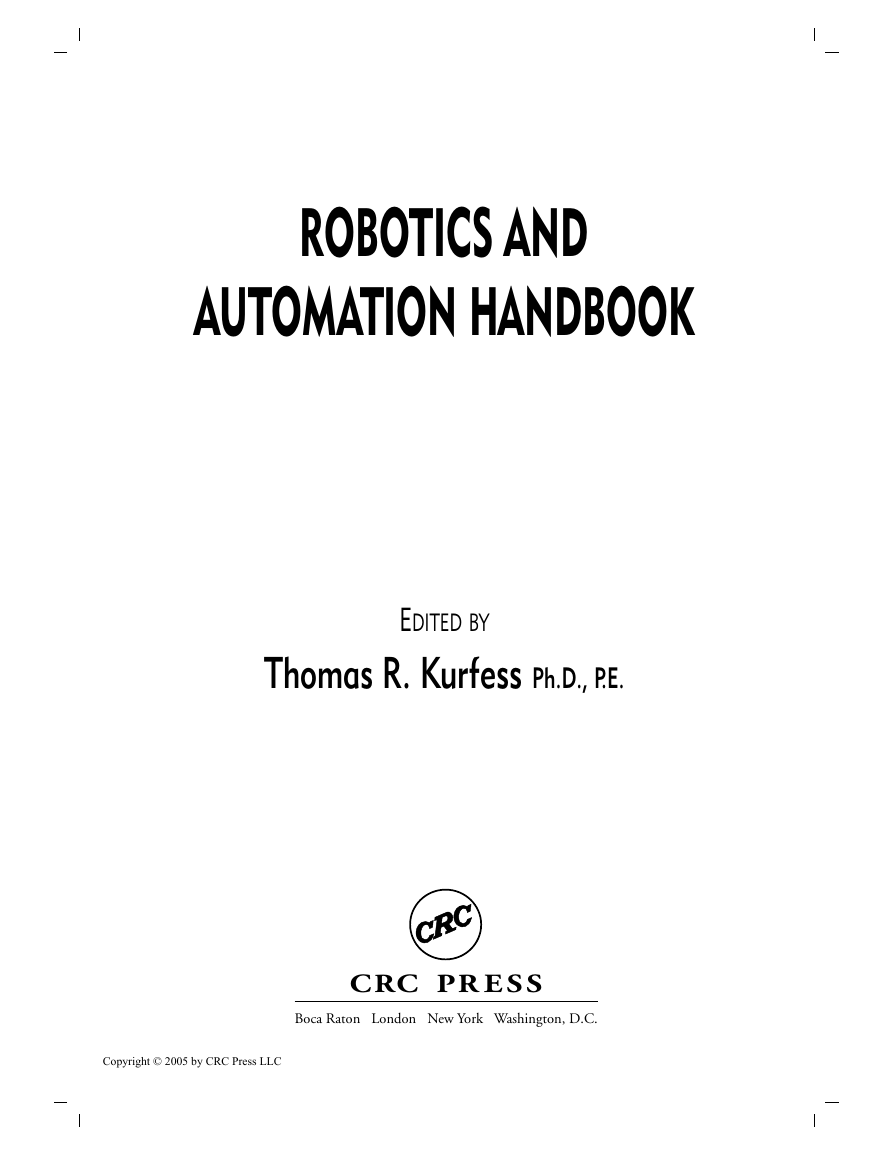
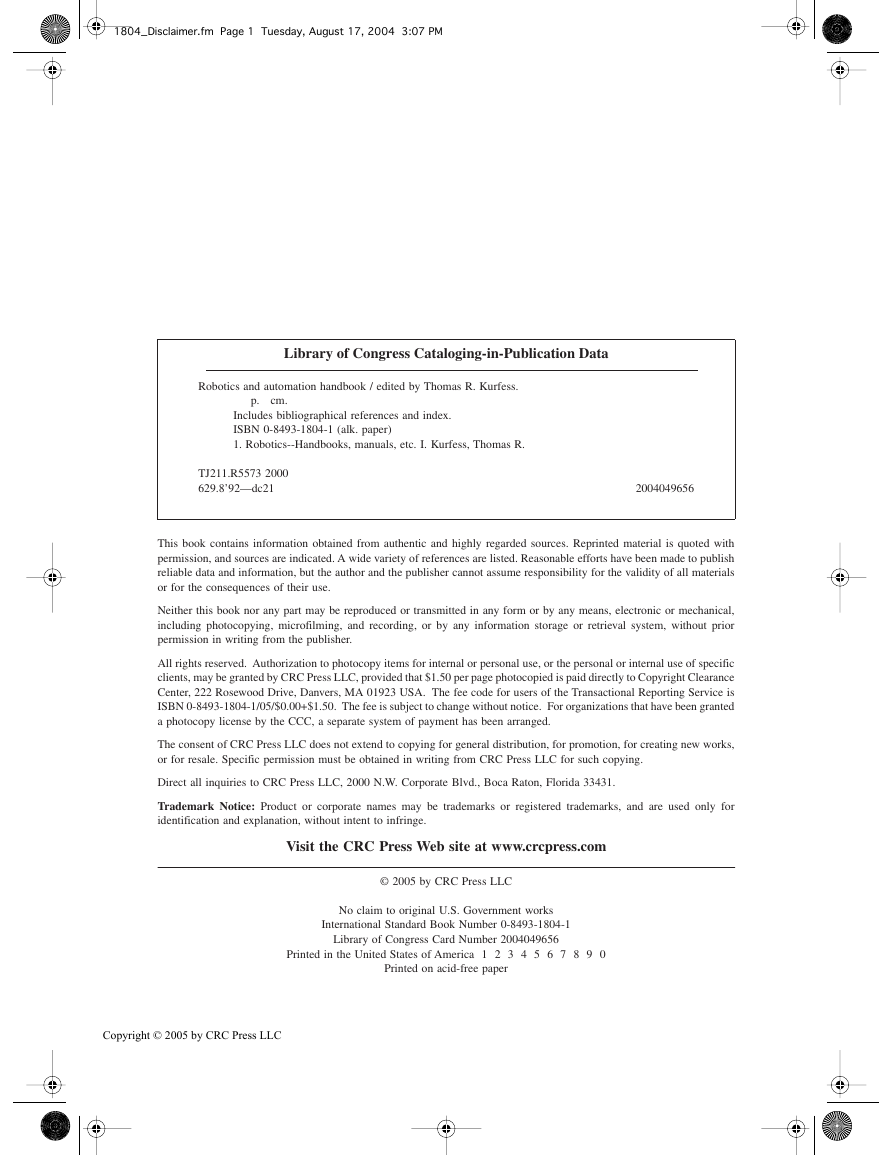
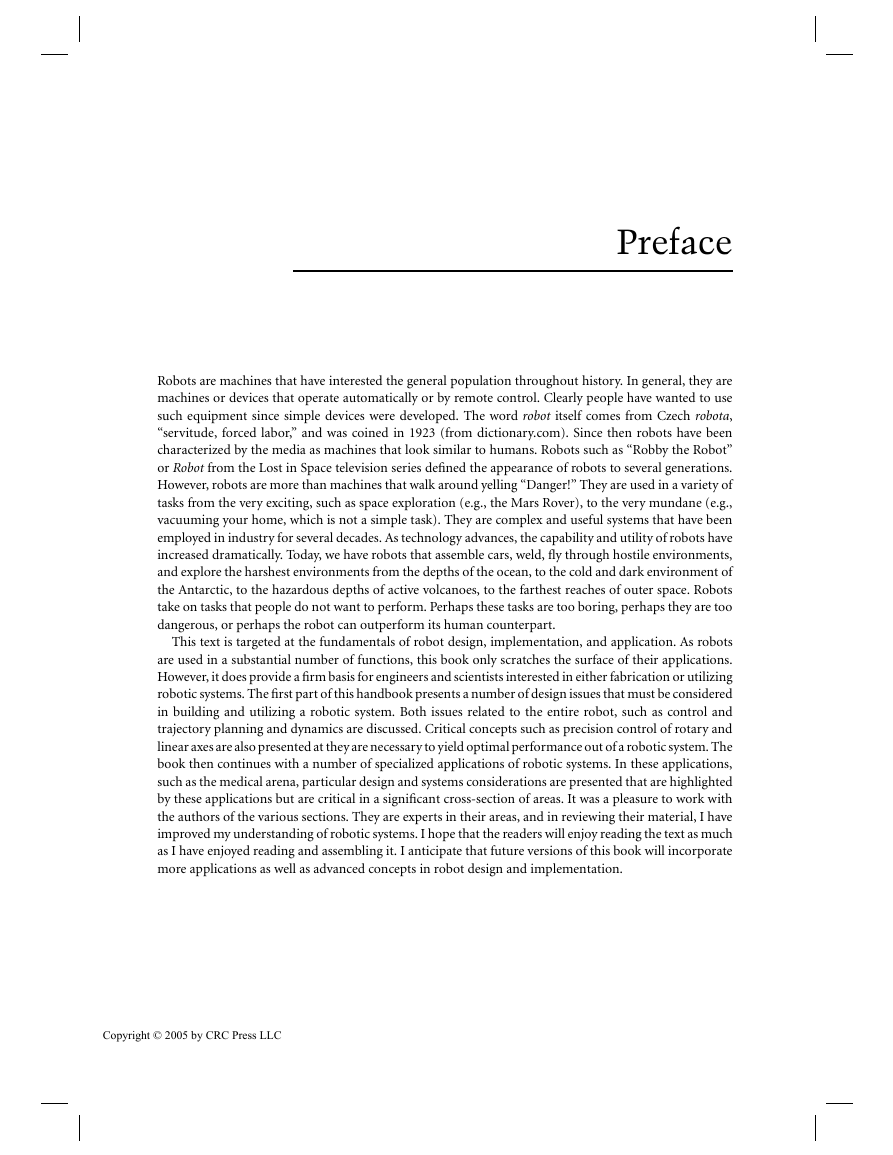
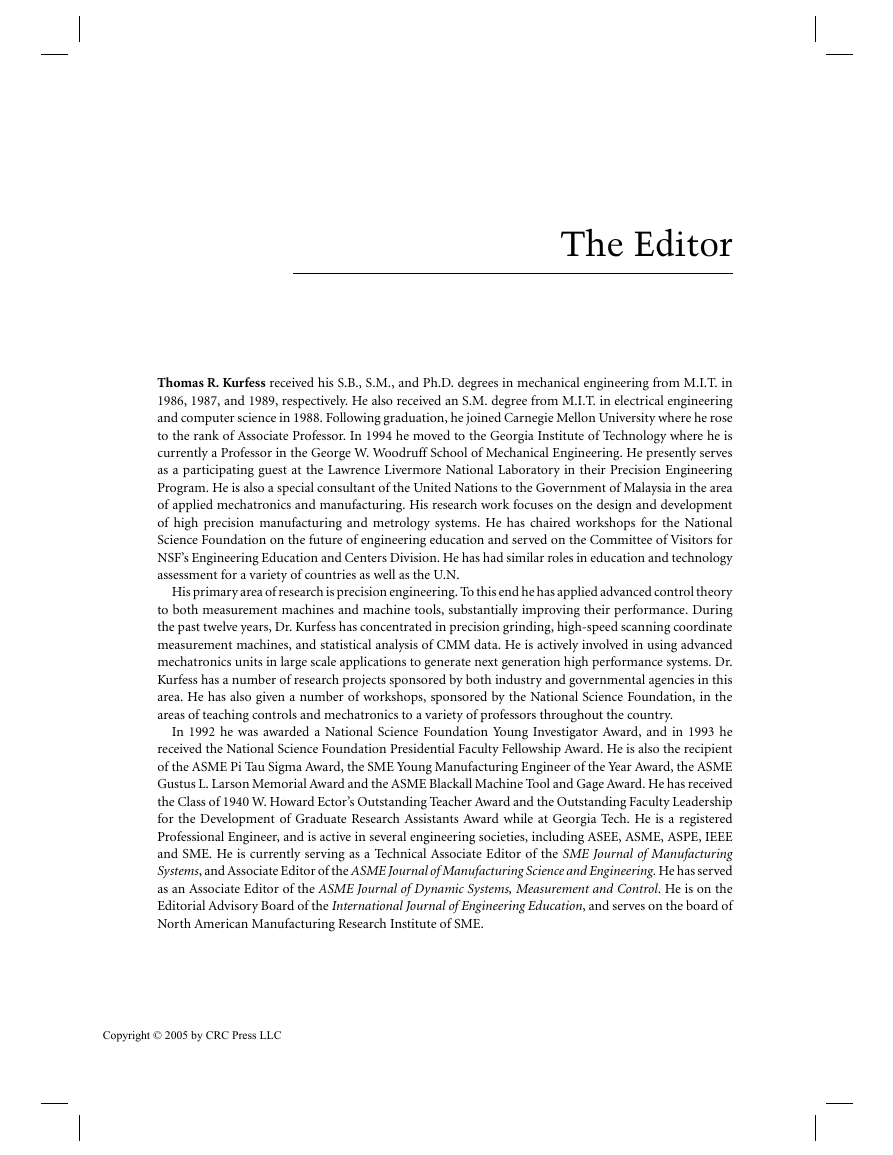
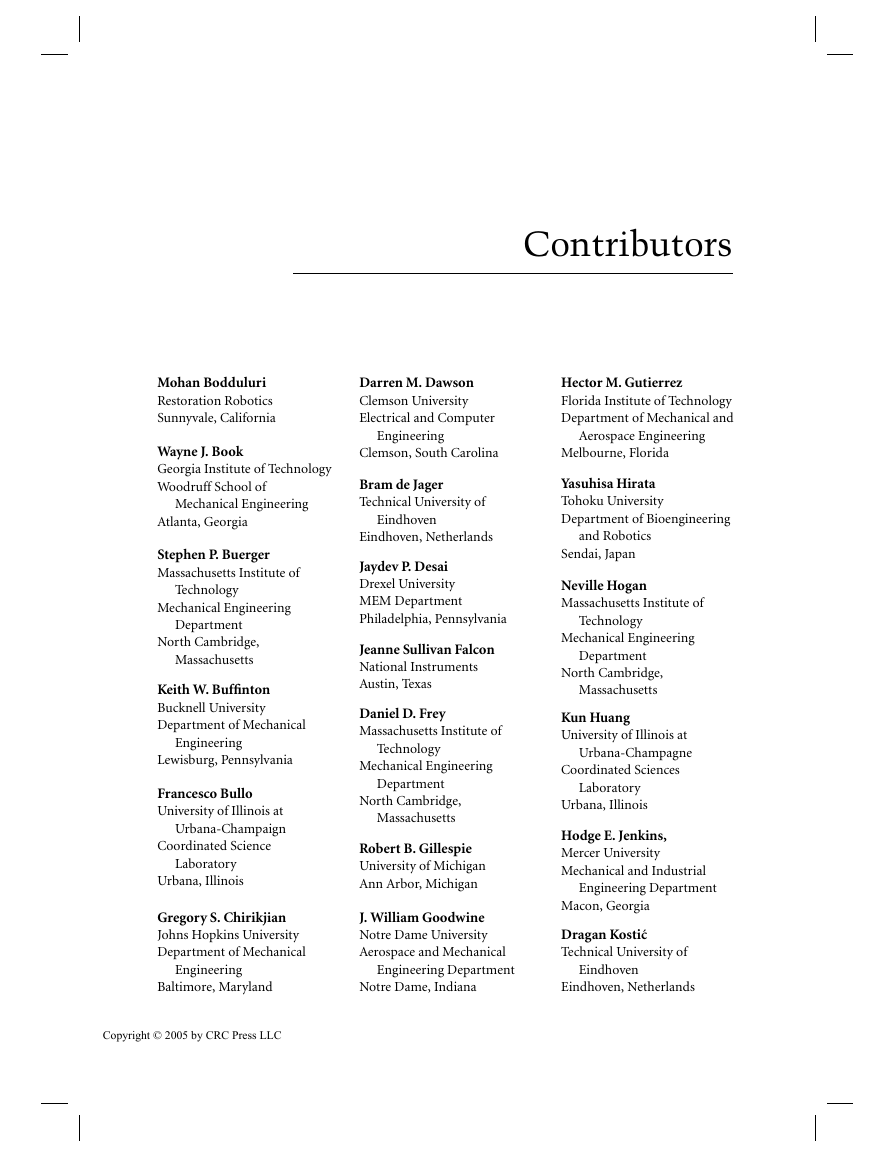
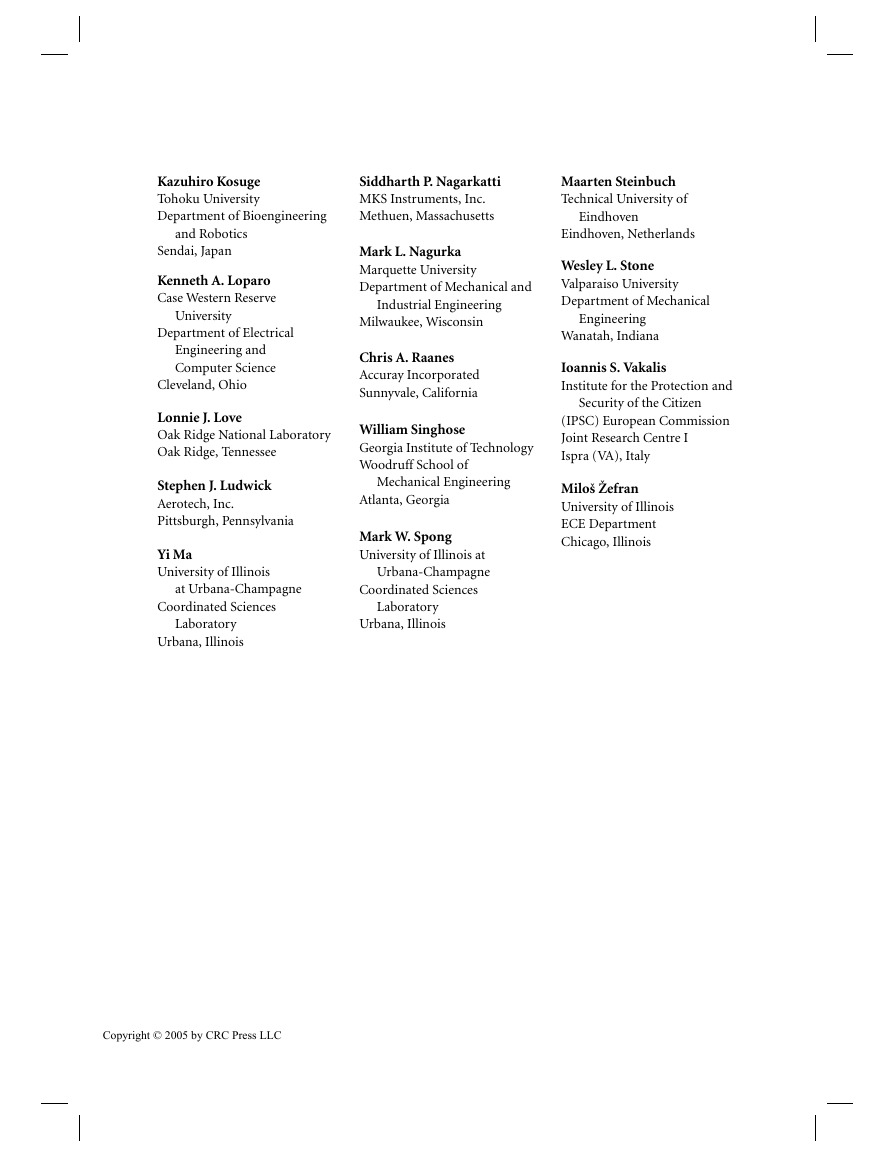
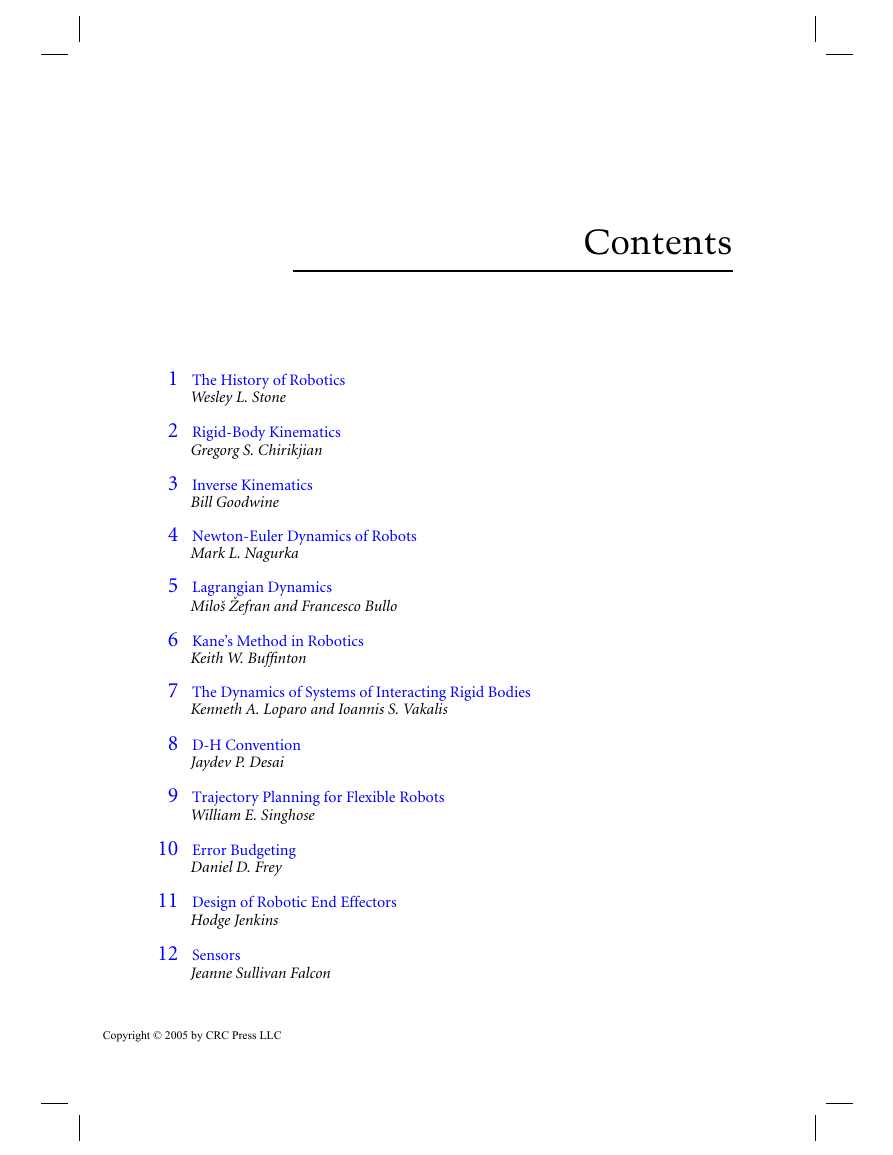
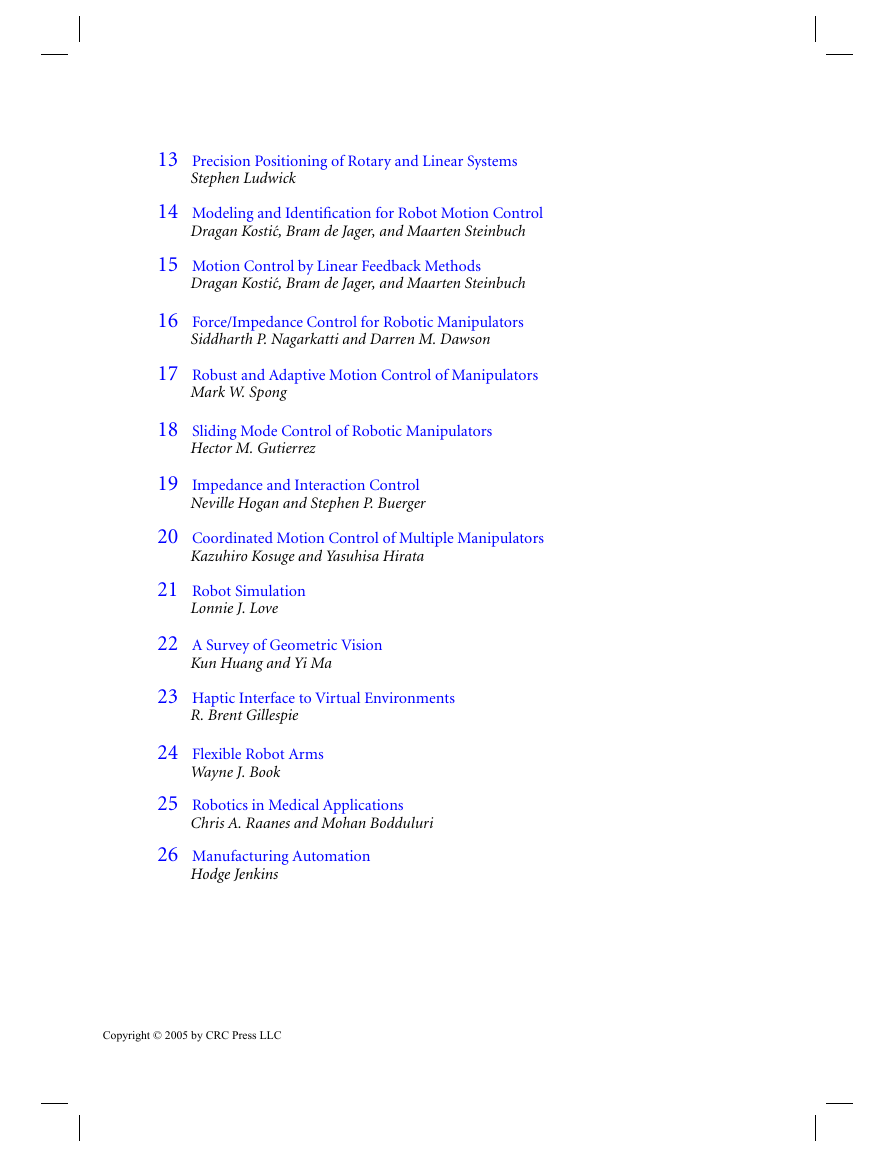








 2023年江西萍乡中考道德与法治真题及答案.doc
2023年江西萍乡中考道德与法治真题及答案.doc 2012年重庆南川中考生物真题及答案.doc
2012年重庆南川中考生物真题及答案.doc 2013年江西师范大学地理学综合及文艺理论基础考研真题.doc
2013年江西师范大学地理学综合及文艺理论基础考研真题.doc 2020年四川甘孜小升初语文真题及答案I卷.doc
2020年四川甘孜小升初语文真题及答案I卷.doc 2020年注册岩土工程师专业基础考试真题及答案.doc
2020年注册岩土工程师专业基础考试真题及答案.doc 2023-2024学年福建省厦门市九年级上学期数学月考试题及答案.doc
2023-2024学年福建省厦门市九年级上学期数学月考试题及答案.doc 2021-2022学年辽宁省沈阳市大东区九年级上学期语文期末试题及答案.doc
2021-2022学年辽宁省沈阳市大东区九年级上学期语文期末试题及答案.doc 2022-2023学年北京东城区初三第一学期物理期末试卷及答案.doc
2022-2023学年北京东城区初三第一学期物理期末试卷及答案.doc 2018上半年江西教师资格初中地理学科知识与教学能力真题及答案.doc
2018上半年江西教师资格初中地理学科知识与教学能力真题及答案.doc 2012年河北国家公务员申论考试真题及答案-省级.doc
2012年河北国家公务员申论考试真题及答案-省级.doc 2020-2021学年江苏省扬州市江都区邵樊片九年级上学期数学第一次质量检测试题及答案.doc
2020-2021学年江苏省扬州市江都区邵樊片九年级上学期数学第一次质量检测试题及答案.doc 2022下半年黑龙江教师资格证中学综合素质真题及答案.doc
2022下半年黑龙江教师资格证中学综合素质真题及答案.doc